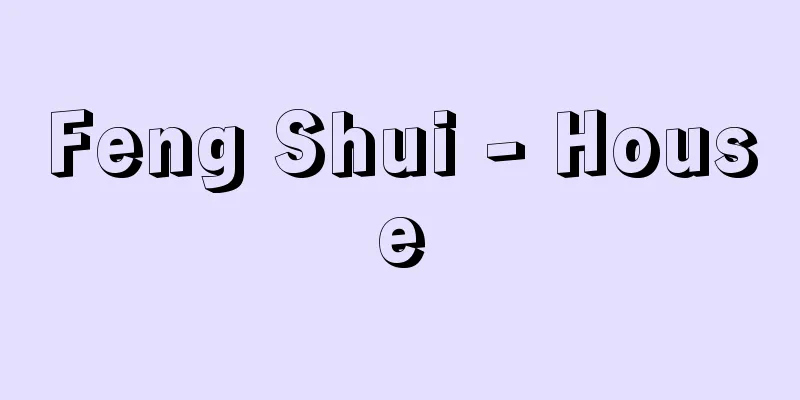Feng Shui - House

|
A method of divination that believes that the location and structure of a house or residence affect people's destiny, and judges the auspiciousness or ill fortune of its placement. It originates from the "direction theory" based on the ancient Chinese idea of Yin-Yang and the Five Elements. It was introduced to Japan long ago, and it became customary to use divination to determine the auspiciousness or ill fortune of the placement of the house when selecting the imperial capital, building shrines, temples, palaces, and building houses. Meanwhile, "direction taboos" related to moving or going out also became common. The main driver of this was the activities of onmyoji (magicians) as a result of the establishment of onmyodo (way of the way of the dead), and its spread to the construction of castles and residences from the Middle Ages onwards, and in the early modern period, the trend spread widely among the general public, and complex and strange theories about house physiognomy were spread by popular fortune tellers. And rather than taboos when building a house, it became common to use divination to determine the auspiciousness or ill fortune of one's fortune according to the house physiognomy. A survey conducted after World War II (1947-50) also found that 46.5% of people believed in the fortune-telling of houses, and as many as 66% performed 'kimon-yoke' (protection against evil spirits). There are two types of directional theories: those in which the fortunes of directions are fixed, and those in which they fluctuate depending on the cycle of the calendar. In particular, the former is dominated by popular belief in the 'kimon' (demon gate). The northeast direction is known as the 'kimon' (southwest is called the 'ura-kimon'), and people avoid placing gates, entrances, toilets, etc. in that direction, or take special measures to ward off evil spirits. There was also a trend to build shrines and temples in cities to ward off evil spirits, similar to the 'kakekomi' (recessed wall) at the Kyoto Imperial Palace to ward off evil spirits (such as Kan'ei-ji Temple in Edo and Enryaku-ji Temple in Kyoto). On the other hand, there are many ways to judge the fortune of directions, such as "unlucky directions" such as Ansatsuken, Goko-satsu, and Teki-satsu according to "Kuseijutsu," or taboo directions for traveling according to the calendar days of Konjin, Hachishogun, and Dokujin, and popular fortune-telling books such as "Sanseishō" are also used as a basis for this. The above survey also shows that in addition to the Kimon, popular beliefs about directions such as Konjin, Ansatsuken, Teki-satsu, Hachishogun, Tenichitenjō, and Goko-satsu are still alive. On the other hand, there are many popular beliefs about taboos in housing that are not based on physiognomy that have been handed down separately among the general public. People avoided strangely shaped houses and the remains of temples and shrines, and were averse to cursed or ill-natured places, and the location of toilets, storehouses, wells, and entrances were also associated with various directions and other taboos. There are complex legends about the flowers and trees planted on houses that determine whether they bring good or bad luck, and the idea that the feng shui and other conditions of a home affect the fortunes of the people who live there is still widely held to this day. [Toshimi Takeuchi] "Tadao Iijima, Astronomical Calendar and the Yin-Yang Five Elements Theory" (1979, Daiichi Shobo)" ▽ "The Ministry of Education Superstition Research Council, ed., "The Reality of Superstitions - Japanese Folk Beliefs 1" (1949, Gihodo Publishing)" ©Shogakukan "> Feng Shui board Source: Shogakukan Encyclopedia Nipponica About Encyclopedia Nipponica Information | Legend |
|
屋敷、家屋の位置や構造が人々の運命に影響すると信じ、その配置方法の吉凶を判断する占法。中国古代の陰陽五行(いんようごぎょう)思想に基づく「方位説」に由来する。古く日本にも伝来して、帝都の選定、社寺宮殿の造営はじめ、住宅建設などにもその配置の方位の吉凶を卜定(ぼくてい)するのが例となった。一方、転居や外出などにかかわる「方位の忌み」も一般化していった。陰陽道(おんみょうどう)の定着による陰陽師(おんみょうじ)の活動がその主動因で、その伝流は中世以後の築城や居館の造営にも及び、近世には広く一般民間にもその風潮は波及して、複雑怪奇な家相説が俗間の易占師などの手で流布した。そして造営時の禁忌より、むしろ運勢の吉凶を家相に即して占う形が主となってもいった。第二次世界大戦後の調査(1947~50)でも家相の吉凶を信ずる者46.5%、とくに「鬼門除(きもんよ)け」を実施した者は66%にも及んでいた。方位説には方位の吉凶が固定しているものと、暦日の循環などでそれが変動するものとがある。とくに前者では「鬼門」の俗信が目だつ。北東の方位を「鬼門」(南西を裏鬼門という)として忌み、門、玄関、便所などの配置を避け、あるいは「鬼門除け」に特殊の工作を施したりする。京都御所の鬼門除けの「欠込(かけこみ)」などの類で、都市の鬼門除けに社寺を建てる風もあった(江戸の寛永寺、京都の延暦寺(えんりゃくじ)など)。一方「九星術」による暗殺剣、五黄殺、的殺などの「凶方位」、あるいは金神(こんじん)、八将軍、土公神(どくじん)などの暦日による巡歴方位の忌みなど、方位の吉凶判断は多様で、「三世相」など俗間の易占書がそのよりどころともなった。前掲調査によっても鬼門のほか金神、暗剣殺、的殺、八将軍、天一天上、五黄殺などの方位俗信がなお生きていることがうかがわれる。一方、民間には家相説によらぬ幾多の住居禁忌の俗信が別に伝承されてきた。異形の屋敷や寺社の跡地を避け、祟(たた)り地、因縁地を忌み、あるいは便所、土蔵、井戸、門口などの配置にも方位その他種々の禁忌が伴った。 屋敷に植える花木にも複雑な吉凶判断の伝承があり、家相その他居宅の状況が住む人の運勢に影響を及ぼすという観念は、いまもなお広く残っている。 [竹内利美] 『飯島忠夫著『天文暦法と陰陽五行説』(1979・第一書房)』▽『文部省迷信調査協議会編『迷信の実態――日本の俗信1』(1949・技報堂出版)』 ©Shogakukan"> 家相盤 出典 小学館 日本大百科全書(ニッポニカ)日本大百科全書(ニッポニカ)について 情報 | 凡例 |
Recommend
Non-store sales - Mutenpohanbai
A general term for selling directly to consumers ...
Saimiri oerstedi (English spelling)
…[Hironari Hayaki]. . … *Some of the terminology ...
Wood Mouse - Wood Mouse
…Tupai means squirrel in Malay, and as its name s...
Gandhi-Irwin Pact
…In the process, he also skillfully integrated th...
Opening Statement - Botoku
In a criminal case, after the opening procedure i...
Bachelor - John Batchelor
British missionary and Ainu researcher. Born in A...
After-shaving powder
...Those with distinctive fragrances are called p...
maximowicz's lily (English spelling) maximowiczslily
...The petals are largely curled back. The very s...
Market - Joshi
A type of market in Korea, it does not have any sp...
Treaty of Peace and Amity between Japan and Russia
A treaty concluded in 1854 between the Edo Shoguna...
Japan Art Academy
A Japanese painting group. The exhibitions they s...
Ashikaga Textiles - Ashikaga Orimono
A general term for textiles produced in Ashikaga ...
Household equality system (English: hù děng zhì)
A system in China that ranks households according ...
Flower garden plants - kakien geishokubutsu
...The number of species of plants cultivated for...
Tucano (English spelling)
The Tukano, in the broadest sense of the word, are...


![Kuze [village] - Kuze](/upload/images/67cb68fb479ac.webp)

![Yasugi [city] - Yasugi](/upload/images/67cd0b29dd3d6.webp)

![Kainan [town] - Kainan](/upload/images/67cb2a0121ef7.webp)


